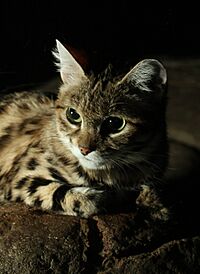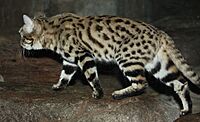Black-footed cat facts for kids
Quick facts for kids Black-footed cat |
|
|---|---|
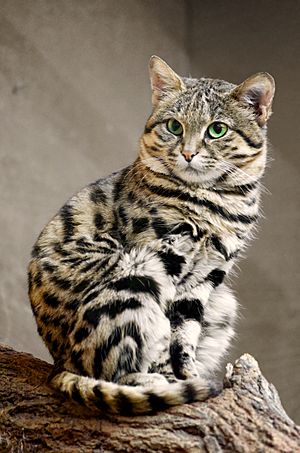 |
|
| Conservation status | |
| Scientific classification | |
| Genus: |
Felis
|
| Species: |
nigripes
|
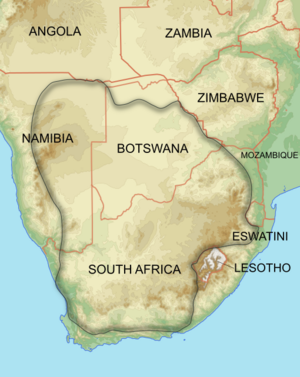 |
|
| Distribution of the black-footed cat in 2016 | |
The black-footed cat (Felis nigripes) is also known as the small-spotted cat. It's the smallest wild cat in Africa. It grows to about 35 to 52 centimeters long (head and body). Even though it's called 'black-footed', only the bottoms of its paws are dark. Its fur has bold spots and stripes, which helps it hide, especially at night. It also has black lines from its eyes down its cheeks, and its tail has a black tip.
This cat was first found in South Africa in 1824. It lives only in the dry grasslands and savannas of Southern Africa. You can find it in parts of South Africa, Botswana, Namibia, Angola, and Zimbabwe. Since 2002, it has been listed as a vulnerable species by the IUCN Red List. This means its numbers are going down. Threats include hunting of its prey, being hunted itself, car accidents, and attacks by dogs.
Scientists have studied black-footed cats using radio trackers since 1993. This helps them watch the cats in their natural homes. These cats usually rest in burrows during the day. They hunt at night, traveling about 5 to 16 kilometers to find food. They eat many different small animals, like rodents and birds. They can even jump up to 1.4 meters high to catch birds in the air! A female cat usually has two kittens between October and March. The kittens are ready to be on their own after about four months.
Contents
What Does a Black-footed Cat Look Like?
The black-footed cat has sandy-colored fur covered in black spots. Its head is a bit darker, but lighter above its eyes. It has white whiskers and dark brown hairs on its ears. Some spots on its neck and back look like stripes. Its legs also have stripes, and its tail has confusing spots. The undersides of its paws are black or dark brown.
The color of its fur can change. Cats in the northern areas of their home range are lighter. Those in the south have clearer spots and stripes. Its fur gets thicker and longer in winter. Like other Felis cats, its eye pupils become thin lines in bright light. Their eyes can be light green to dark yellow.
The black-footed cat is the smallest wild cat in Africa. Females are about 33.7 to 36.8 cm long, with tails of 15.7 to 17 cm. Males are a bit bigger, from 42.5 to 50 cm long, with tails of 15 to 20 cm. Their tails are about half the length of their bodies.
Females weigh about 1.1 to 1.65 kilograms. Males are heavier, weighing 1.6 to 2.45 kilograms. To compare, the African wildcat is almost three times bigger!
Where Do Black-footed Cats Live?
The black-footed cat lives only in Southern Africa. Its home range is smaller than other small cats in the area. It lives in open, dry savannas and bushy areas. These places have short grasses, low bushes, and scattered taller grasses. It can be found in areas where it rains about 100 to 500 millimeters each year. Some have even been seen high up in the Drakensberg mountains, at about 2000 meters.
How Do Black-footed Cats Behave?
Black-footed cats are active at night and usually live alone. The only time they are not alone is when a mother is raising her kittens. During the day, they rest in hollow termite mounds or in empty burrows made by other animals like South African springhares or aardvarks. They can dig to make these burrows bigger.
After the sun sets, they come out to hunt. If they sense danger, they quickly hide. They often use termite mounds for cover or to have their babies. If they are trapped, they fight very fiercely. Because they are so brave, people in South Africa sometimes call them 'anthill tigers'. There's even an old legend that says a black-footed cat can kill a giraffe! This story just shows how brave and tough they are.
Unlike most cats, they are not good at climbing trees. Their bodies are strong and their tails are short, which isn't great for climbing. However, one cat was seen resting in the lower branches of a camelthorn tree.
A female cat usually roams an area of about 6 to 15 square kilometers in a year. A male cat roams a larger area, about 19 to 23 square kilometers. A male's area can overlap with the areas of one to four females. They use scent marks to show their territory. They also rub against things, scratch with their claws, and leave their droppings in clear spots. Their calls are louder than other small cats, so they can be heard far away. When they are close, they purr or gurgle. If they feel threatened, they will hiss and growl. On average, they travel about 8.4 kilometers each night looking for food.
It's hard to count these cats because they are very secretive. They also move quickly and don't use roads or paths like other cats.
Hunting and What They Eat
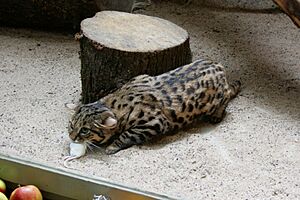
Black-footed cats hunt at night, no matter the weather. They hunt even when it's very cold (-10°C) or very hot (35°C). They attack prey from behind, using their front paws to hold it down. They have three main ways of hunting:
- Fast hunt: They move quickly (2 to 3 km/h) to chase prey out of hiding.
- Slow hunt: They sneak slowly (0.5 to 0.8 km/h) through the grass, looking around carefully.
- Sit and wait: They wait still in front of a rodent's home, sometimes with their eyes closed. Their ears keep moving, and they open their eyes as soon as they hear a sound.
They travel about 5 to 16 kilometers each night, moving in circles and zig-zags among bushes and termite mounds.
Because they are small, black-footed cats mostly hunt small animals like rodents and birds. But they can also catch Cape hares, which are heavier than them! They need a lot of energy, so they eat about 250 to 300 grams of prey each night. This is about one-sixth of their own body weight!
In 1993, scientists watched two cats hunt for many hours. They caught an animal every 50 minutes and killed up to 14 small animals in one night. They killed small mammals by biting their necks or heads and ate them whole. They stalked birds quietly, then chased them and jumped up to 1.4 meters high to catch them in the air. They ate small birds whole. For larger birds, they would pluck the feathers, eat for hours, and then hide the rest in holes, covering them with sand. They have even been seen eating a dead baby springbok that weighed almost 3 kilograms. They also eat a small amount of insects like termites and grasshoppers.
Scientists have found that black-footed cats eat 54 different kinds of prey. Small mammals are their most important food, especially the gerbil mouse. They get all the water they need from their food, but they will drink water if it's available.
Reproduction and Life Cycle
In zoos, male black-footed cats can have babies when they are nine months old. Females can have babies at seven months. Females are ready to mate for about 36 hours. Pregnancy lasts 63 to 68 days. A female can have up to two litters (groups of kittens) per year. This usually happens between October and March. They usually have one or two kittens, but sometimes four.
Kittens weigh about 60 to 93 grams when they are born. They are born blind and helpless, but they can crawl after a few hours. Their eyes open when they are three to ten days old. Their first teeth appear when they are two to three weeks old. They start eating solid food within one month and stop drinking milk at two months old. Their adult teeth grow in when they are about five months old.
In zoos, mother cats often move their kittens to a new hiding spot every six to ten days after they are born. This is more often than other small cats. Kittens can walk within two weeks and start climbing at three weeks. In the wild, kittens are born in burrows or termite mounds. From four days old, the mother might leave her kittens alone for up to 10 hours at night. By six weeks old, they can move fast and often leave the den. Young cats can be hunted by other animals like black-backed jackals, caracals, and night-hunting birds. They become independent at three to four months old. Black-footed cats in zoos have lived for up to 15 years.
Health Issues
Both wild and zoo black-footed cats can get a disease called AA amyloidosis. This causes long-term swelling and often leads to kidney failure. Wild cats can also catch diseases from pet dogs and cats.
Threats to Black-footed Cats
Many things threaten black-footed cats. These include:
- Poison and traps: People sometimes use poisons or traps to control other predators, but these can harm black-footed cats too.
- Habitat loss: Too much grazing by farm animals can destroy the places where these cats live.
- Less prey: The number of South African springhares, a main food source, is going down.
- Other predators: Larger predators can hunt black-footed cats.
- Diseases: They can get sick from diseases.
- Farming practices: Some farming methods are not good for the cats.
- Dogs: Many black-footed cats have been killed by herding dogs.
- Small protected areas: Many protected areas might be too small to keep enough cats safe.
Conservation Efforts
The black-footed cat is listed on CITES Appendix I. This means it is highly protected. Hunting them is illegal in most of their home range, including Botswana and South Africa.
Studying Black-footed Cats in the Wild
The Black-footed Cat Working Group has a research project in South Africa. Between 1992 and 2018, they put radio collars on 65 black-footed cats. They followed these cats for a long time to learn about how they live together, how big their home areas are, how they hunt, and what they eat. They also use Camera traps to watch the cats and see how they interact with other animals like aardwolves.
Black-footed Cats in Zoos
The Wuppertal Zoo in Germany got black-footed cats in 1957 and successfully bred them in 1963. In 1993, the European Endangered Species Programme was started. This program helps zoos decide which cats should breed to keep their genes healthy and avoid inbreeding. The main book that tracks all black-footed cats in zoos is kept at the Wuppertal Zoo. As of July 2011, records existed for 726 captive cats since 1964. At that time, 74 cats lived in 23 zoos around the world, including Germany, the United Arab Emirates, the US, the UK, and South Africa. Many zoos have had success in breeding these cats.
See also
 In Spanish: Gato patinegro para niños
In Spanish: Gato patinegro para niños



